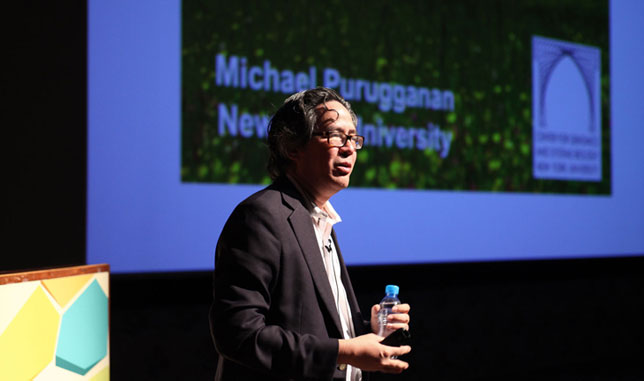WEP 2014: Dr. Michael Purugganan - The Origins of Crop Species

Dr. Michael Purugganan.
While many of the distinguished speakers for KAUST's 2014 Winter Enrichment Program (WEP 2014) were acquainting themselves with the campus, Dr. Michael Purugganan —Professor of Genomics and Biology, and Dean of Science at New York University—was searching Jeddah's busy markets for date fruit. "I'm interested in how evolution works," he said, "particularly how humans and plants are coevolving."
In his WEP 2014 talk, "The Origins of Crop Species," Purugganan offered insights on how recent advances in genome sequencing and data processing are giving scientists a better understanding of how our modern crops came to be. The date fruit he collected in Jeddah represent just one of many domestic plant types whose evolution he hopes to understand. "We think that by looking at the past, there are some lessons we might be able to learn about how to feed the world."
Understanding Domesticated Plants
Domesticated plants make for an ideal study of evolution. They evolved recently, they're subjected to intense selection pressures year after year, and in many cases there's an archeological record from the first dates of domestication through to the present. In Purugganan's view, the adaptation of plants to human farms (and of humans to eat these plants) is much the same as the natural interactions between plant and animal species that have evolved to cooperate. Flowers feed bees, for instance, and in turn bees pollinate flowers.
Purugganan has already had some breakthroughs. There are two distinct varieties of modern rice: japonica, which includes the sticky white rice found in sushi, and indica, the long-grained rice you'd expect to find on menus in Saudi Arabia. "We thought domestic rice evolved twice," he said.
Using Mathematical Models to Study Plants
Together with Carlos Bustamante of Stanford University and several others, Purugganan applied a new mathematical model to a range of rice genomes in order to better understand their relationship, and to test the model. Then, almost as an afterthought, the team adjusted the model for only one origin of domestic rice. Suddenly it fit the data much better. Bustamante was the first to realize the significance of the results: both rice strains shared a common domestic ancestor.
"My first reaction was, 'Carlos, you're wrong,'" Purugganan said, insisting to the team that some mistake had been made. Previous genetic studies appeared to confirm that domestic rice had evolved twice. But in applying the detailed new model to the old data, they found that previous studies had oversimplified and thus had also been mistaken. "The evolutionary process is much more complicated than we thought," Purugganan said.
Going forward, Purugganan is using statistical analysis to identify which sites on domestic plant genomes have been important in adapting to various aspects of domestication. He hopes that this understanding will help plant breeders and geneticists in adapting our crops to a changing planet. "There are a lot of challenges we face in order to be able to feed a hungry world," he said. "Plant genomics is one part of the possible solutions."